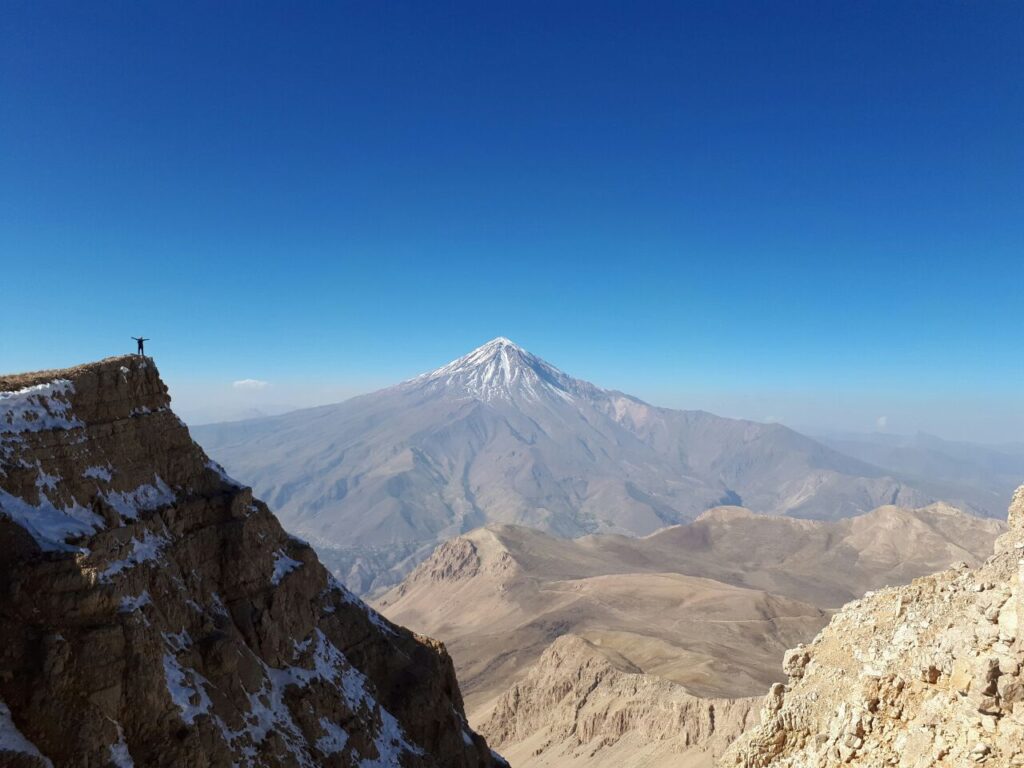
With 5610 meter above sea level (based on National Cartographic Center of Iran measurements in 2005-2006), mount Damavand is the highest peak in the Near East. This cone-shaped volcano with its permanent snow cover stands majestically on its own. The surrounding peaks, all significantly lower, pay tribute to her. Once seen, every mountaineer will feel the urge to climb Mount Damavand.
Ascending Mount Damavand (via most frequented southern route)

To climb Mount Damavand, all foreigners require a climbing permit. Therefore, first stop is the Iranian Mountaineering Federation in the village of Polour. They can issue the permit on the spot (50 USD per person at time of writing – Apr 2021). There are ongoing discussions to limit the total daily hikers. There are proposals that require both foreigners and Iranians to register beforehand. Up to now (Apr 2021), this hasn’t been put into practice.

You can leave your car in the parking of the Mountaineering Federation. From this car park, old battered Land Rovers drive you up along a very rough rocky track to Goosfandsara (3020m). All drivers are members of the local “union”. Having a monopoly together, customer care is limited.
In Goosfandsara, there is a little mosque and some porto-cabins where you could sleep (if needed). This is also the location where one negotiates the services of (a) porter(s) and mules for getting heavy luggage to the hut.

So most hikers start their ascent at 3020 meters and climb on their first day to the staffed hut at 4200 meters. Around the hut is also ample space for pitching tents.
From the hut (4200m) to the summit (5610m), one has to gain another 1400 meters. On summit day, most hikers start 5am-6am. Late summer, there are no technical difficulties. However, one should not underestimate the altitude. At several occasions, there is more than 1 track but in the end, all will come together so route finding is not a major issue.
If you pass a frozen waterfall a little distance from the track on your right hand side, the good news is you have passed 5000m.

When you notice the smell of Sulphur (and see smoke exiting from rocks covered by a yellow deposit), you are getting close to the summit. Once on the crater edge, one quickly reaches the summit marker, 5610m!
Reaching the summit means you are (only) half-way. Many hikers return to the hut, overnight here and descent to the road the next day (trip 3 days). The extreme fit manage to descent from the summit to the hut and then continue to their car in a single day (trip 2 days).
Practical Information
Best time of the year to climb mount Damavand is late summer with reduced snow coverage, long daylight and relatively mild temperatures (compared to winter) and stable weather. However, one should always bring sufficient protective warm clothing (including ski goggles type eye protection) in case of a sudden weather change.
In the summer midday sun, UV levels are extreme. Therefore, many Iranian mountaineers protect themselves wearing long sleeved shirts, gloves and full-face masks, even at lower levels where the temperatures might be warm (in particular for Europeans).
Pride of Iran will be delighted to organize your Mount Damavand climbing trip and proposes to visit some Iranian cultural sites afterwards. Please see our proposed itinerary.
Good website for weather forecast for Mount Damavand.
Mount Damavand in Iranian Folklore
Surrounded by their enemies, Iranian king Manuchehr had to accept the conditions for peace set by Turanian king Afrasiab. To establish a new border, they agreed that whatever land falls within the range of a single bow-shot shall be returned to the Iranians. The rest should then fall to the Turanians.
Arash, is asked to be the archer. He climbs Mount Damavand, then fires the specially-prepared arrow at dawn. The arrow then travels a great distance before finally landing in a walnut-tree near the river Oxus. Arash put his soul in the shot. Thus immediately after firing the arrow, he is body is torn into pieces. Due to this extraordinary feat, Arash has become a national hero (and figures on the logo of Pride of Iran).
